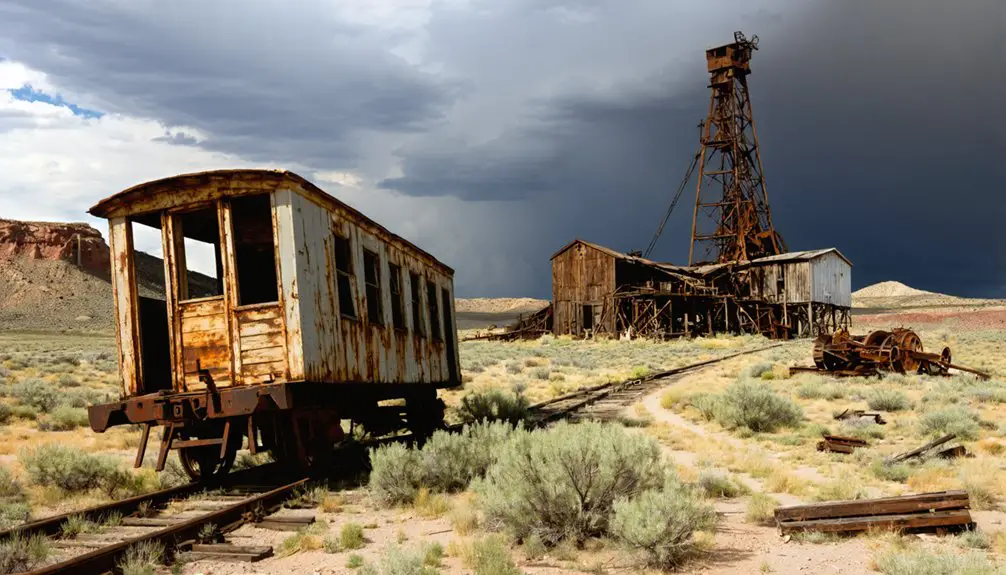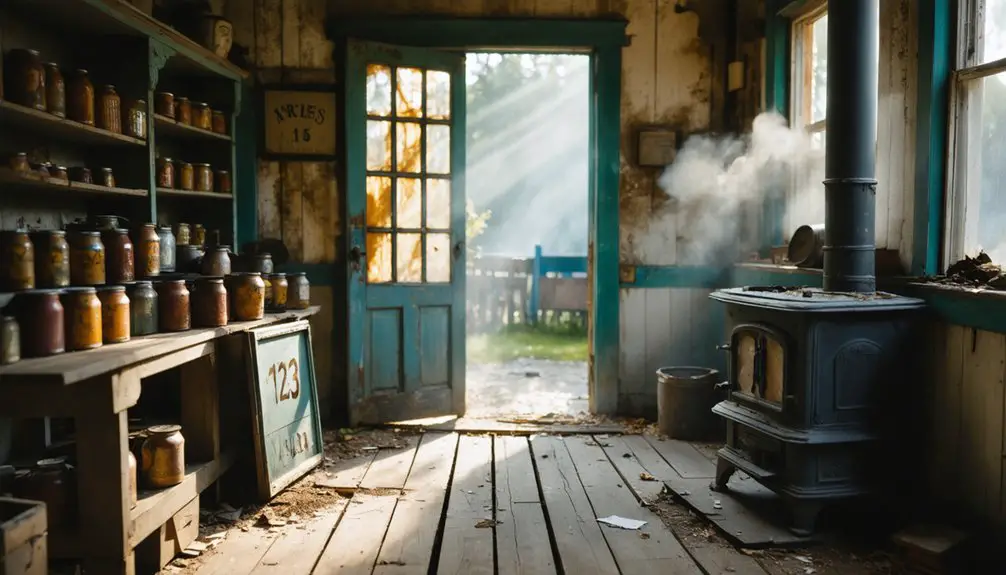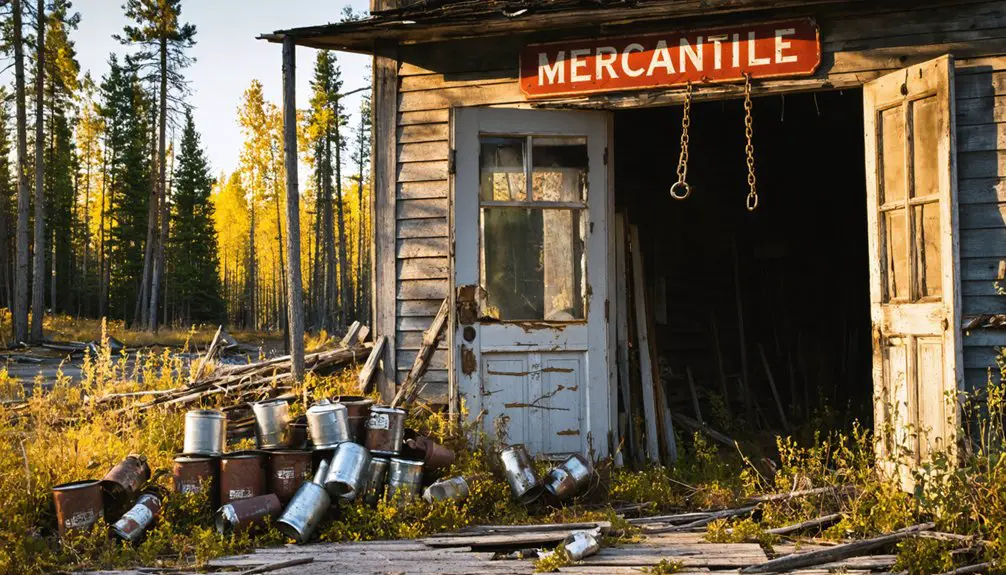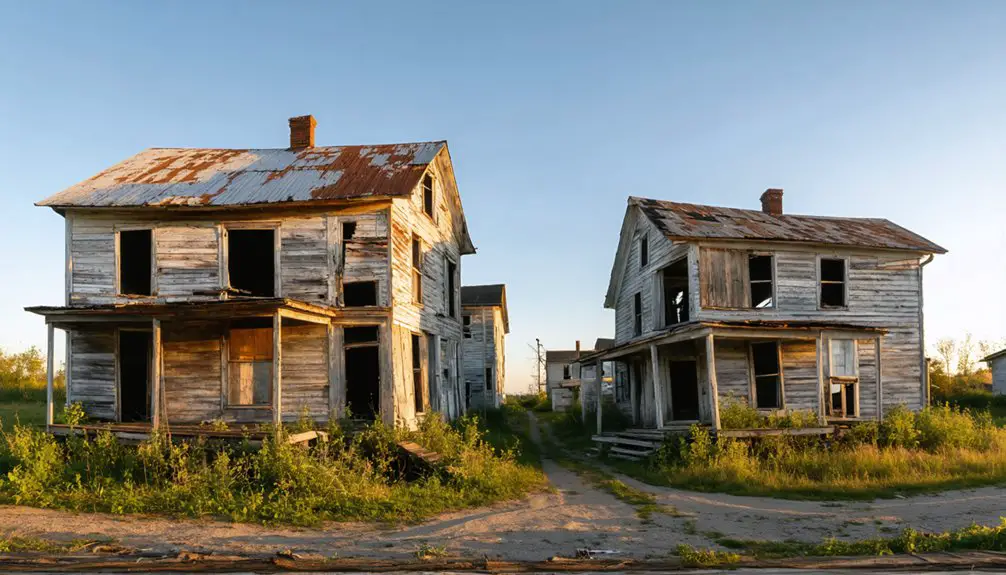You’ll find Old Torodah nestled along Toroda Creek in Washington state, where gold and silver discoveries sparked a mining boom in 1897. The settlement quickly grew to 470 residents, with canvas tents and log buildings lining its main street as miners extracted precious metals using mercury amalgamation and cyanidation. While the town thrived briefly, economic challenges and declining gold prices led to its abandonment. The remote ghost town‘s remnants still tell tales of its prosperous past.
Key Takeaways
- Old Torodah was established in 1897 following gold and silver discoveries at Sheridan, Washington, reaching a peak population of 470 residents.
- The mining town featured canvas tents and log buildings along main street, with the Bodie Mine extending 1,500 feet underground.
- Economic decline began with World War restrictions and falling gold prices, leading to mine closures and mass exodus in the 1930s.
- Historic remnants include log buildings and stone foundations at 2,592 feet elevation, accessible via Toroda Road with high-clearance vehicles.
- Visitors can explore the abandoned commercial district, including Gailliac Hotel and general store ruins, from spring through fall.
The Birth of a Gold Rush Settlement
When gold and silver ore was discovered at Sheridan, Washington in 1897, it sparked the creation of Toroda, a settlement that would emerge along more accessible terrain.
Miners quickly realized that Sheridan’s remote mountain location made operations difficult, so they established their mining community along Toroda Creek instead.
You’ll find the town’s name has Native American roots, translating to “Dorothy” in local dialect – named after John Lutes’ wife.
The gold discovery triggered a rapid transformation of the area.
Within a year, you’d have seen the population explode to around 470 residents, with some reports suggesting up to 2,000 miners and prospectors crowding the region.
Most lived in canvas tents, creating a typical scene of a western boom town driven by dreams of striking it rich.
Like many mining communities of the era, news of the discovery spread through signal fires that could be seen for miles around.
The settlement grew to include substantial log buildings that lined both sides of the main street.
Life in Early Mining Days
You’d have found Old Toroda’s miners working grueling shifts using mercury amalgamation and cyanidation methods to extract gold from ore that yielded up to 20 ounces per ton in the richest veins.
The mine was part of the Cascade District, located just 12 miles northwest of Republic in Okanogan County.
After long days at the Bodie Mine, which extended 1,500 feet underground, workers would return to the town’s communal facilities, including bunkhouses and a shared kitchen that served up to 470 residents at the settlement’s peak.
When darkness fell, the mining community gathered in these common spaces, creating a tight-knit social atmosphere that helped them cope with their isolated mountain existence and harsh working conditions. Operations ran continuously until World War II priorities forced the mine to close in 1941.
Daily Routines and Hardships
Life in Old Torodah’s mining heyday demanded extraordinary physical and mental resilience from its inhabitants.
You’d start your daily struggles before dawn, laboring 10-12 hours in treacherous mine shafts where tunnel collapses and toxic dust were constant threats. Your survival tactics included adapting to harsh winters in basic tents or log cabins, relying on simple meals of preserved goods and whatever the general store could stock. The Wrigley brothers’ steam mill modernized operations but workers still faced grueling conditions. Twenty-five rustic cabins dotted the landscape, providing basic shelter for the hardworking miners and their families.
Without proper medical facilities, you’d have to treat injuries yourself or risk dangerous travel for help.
Water from Toroda Creek sustained you, though mining contamination made it risky. The community’s survival hinged on cooperation – sharing information about ore veins and helping neighbors through brutal winters when heavy snow cut off crucial supply routes.
Mining Equipment and Methods
Mining operations in Old Torodah relied on three essential types of equipment: ore crushers, concentration devices, and steam-powered mills. You’d find jaw crushers, stamp mills, and ball mills pulverizing gold-bearing ore into fine particles, while Wilfley tables and jigs separated valuable minerals from waste rock. Miners aimed for a yield of 25 percent gold from their concentrated ore before transport.
Mining innovations like mercury amalgamation and cyanidation helped boost gold recovery rates. The historic funicular railway system transported both workers and vital mining supplies to the operation site.
Underground, you’d encounter wooden-supported tunnels with ventilation systems where miners used drift mining and chute-and-pillar methods to extract ore. The challenge of ore transportation was solved through inclined railways that moved materials between mine shafts and valley floors.
Early mines targeted high-grade surface deposits containing up to 20 ounces of gold per ton, though getting ore to distant smelters remained costly until railroad access improved.
Social Life After Dark
After long days operating ore crushers and working underground tunnels, Old Torodah’s miners found refuge in the town’s modest but lively social scene. You’d have found them gathering at the general store, restaurant, and makeshift saloons, where nighttime gatherings helped combat the isolation of frontier life.
With a peak population of 470 in 1898, the small community forged tight bonds through storytelling, music, and shared meals. Like other mining settlements such as Bodie ghost town, Old Torodah would eventually face a swift decline as mineral deposits were depleted.
Miner camaraderie flourished around campfires and in boarding houses, where diverse cultural backgrounds mixed freely. You might’ve heard multiple languages and songs echoing through the settlement after dark.
While law enforcement was minimal, the community largely regulated itself through informal agreements and mutual respect, though occasional brawls and gambling disputes weren’t uncommon in this rugged mountain town.
Notable Buildings and Infrastructure
Today’s visitors to Old Torodah Ghost Town can explore several notable structures that have withstood time’s ravages.
You’ll find weathered wooden homes from the early 1900s, their stone foundations still visible beneath aging timber frames. The historical significance of the town’s industrial past emerges through abandoned mining offices and mill ruins scattered across the landscape. Like many settlements in Okanogan Country, these remaining structures tell stories of a bygone era.
Crumbling stone foundations and dilapidated mining structures tell silent stories of frontier life in this once-thriving industrial town.
Walking the old rail grades, you’ll discover remnants of the town’s essential transportation network, including stone bridge abutments and tunnel entrances.
The schoolhouse stands as a symbol of the community’s former vibrancy, while rusted machinery and equipment along the trails hint at the area’s mining heritage.
Water management structures, including early dam foundations and canal systems, showcase the engineering efforts that once supported this bustling frontier settlement.
Mining Operations and Economic Impact

When prospector Henry DeWitz established his initial claim in 1884 near the original Toroda site, he sparked a mining boom that would transform the region.
By 1898, Toroda’s population had swelled to 470 as miners flocked to the area following gold discoveries at nearby Sheridan.
Mining techniques evolved from simple surface and placer operations to more sophisticated bulk ore milling. Under Northern Gold Corporation’s management in the 1930s, you’d have found 40 miners working round-the-clock shifts, processing 70 tons of ore daily.
The economic fluctuations of gold and silver prices directly impacted the town’s prosperity. When mines were producing, businesses thrived – from general stores to blacksmiths.
However, external factors like World War I and II restrictions, combined with declining gold prices, eventually forced operations to shut down, leading Toroda toward ghost town status.
The Great Decline and Abandonment
You’ll find that Bodie’s dramatic decline began in earnest during the early 1930s when plummeting gold prices and declining ore values made mining operations economically unfeasible.
The exodus of working-age residents seeking opportunities elsewhere triggered a devastating chain reaction, shuttering essential businesses and community services.
Rapid Population Exodus
After reaching its peak population of 470 residents in 1898, Old Toroda experienced a swift and devastating exodus that would transform the bustling mining settlement into a ghost town.
You’ll find that plummeting silver prices and disappointing ore yields triggered massive mine closures, forcing workers to seek opportunities elsewhere. The community dynamics shattered as essential services – the post office, general store, and blacksmith – shuttered their doors.
The migration patterns show a clear shift as residents relocated four miles north to the newer settlement of Bodie, hoping to be closer to remaining mining operations.
Economic Ripple Effects
The economic devastation of Old Torodah extended far beyond its immediate township borders.
You’ll find that the town’s mining legacy created a complex web of economic interdependence throughout the region. As mines closed and workers left, neighboring agricultural communities lost their primary market for crops, while railway stations saw sharp declines in both freight and passenger services.
Local businesses that once thrived on miners’ wages – from general stores to hotels – couldn’t survive the population exodus.
You can trace how the collapse created a domino effect: reduced tax revenues crippled municipal services, property values plummeted, and critical infrastructure fell into disrepair.
The impact reached into every corner of the regional economy, forcing many families to abandon their homes and seek opportunities elsewhere.
Preserved Remnants and Historical Sites

While much of Old Toroda has vanished over time, several significant remnants still mark this once-bustling mining settlement.
You’ll find a couple of old log buildings along Cougar Creek, along with stone foundations that outline the town’s original footprint. These preservation efforts showcase Old Toroda’s historical significance as an essential mining hub.
If you explore the area, you’ll discover remnants of the commercial district that once included the Gailliac Hotel, general store, and post office established in 1898.
The east side of Toroda Creek features newer structures from when the town relocated, though they’re mostly hidden by trees.
Mining-related sites dot the landscape, including old claim locations and operation facilities that tell the story of the area’s gold and silver boom.
Legends and Local Stories
Mysterious tales and unexplained phenomena have shaped Old Toroda’s ghostly reputation since its mining heyday.
You’ll hear accounts of prospectors encountering supernatural occurrences while staking claims, particularly around the properties of Henry DeWitz and his brother. The abandoned mining structures come alive at night with unexplained shadows and noises that echo through the Okanogan Highlands.
Today, you might encounter spectral guardians who watch over the town’s historic sites, manifesting through unexplainable touches and poltergeist activity.
Local residents maintain connections to these spirits through rituals, like leaving vodka offerings for former occupants.
Whether you’re exploring old multi-family homes or mining remnants, ghostly encounters remain deeply woven into Toroda’s identity, serving as both cautionary tales and reminders of the boom town’s dramatic past.
Exploring the Ghost Town Today

Modern-day visitors to Old Toroda will find themselves traversing through a remote landscape at 2,592 feet elevation, where weathered log buildings and stone foundations tell stories of the town’s mining past.
You’ll need a high-clearance vehicle to access the site via Toroda Road off Route 20, especially during snowy winters.
As nature reclaims the abandoned townsite, you can trace the original main street while exploring ruins of the general store, livery barn, and blacksmith shop.
The best times to visit are spring through fall, when you’ll have clearer access to photograph the ghostly encounters between decaying structures and seasonal foliage.
Remember, you’re on your own out here – there’s no tourist infrastructure, limited cell service, and wildlife roams freely.
Pack accordingly and combine your visit with nearby ghost towns like Bodie and Molson.
Connected Ghost Towns of Okanogan County
Throughout Okanogan County, a network of fascinating ghost towns tells the story of Washington’s mining era, with Old Torodah connecting to notable sites like Ruby City, Molson, and Chesaw.
You’ll discover these Okanogan connections along scenic routes that wind through the highlands, where each ghost town showcases unique remnants of frontier life.
Ruby City, once known as the “Babylon of the West,” stands with its stone foundations as a symbol of mining prosperity.
In Molson, you can explore the preserved stone schoolhouse and state bank building, while Chesaw’s remains are accessible via the Loomis-Similkameen loop.
The ghost town significance extends beyond individual sites, as these interconnected communities once thrived together through mining, trading, and social activities, sharing common boom-and-bust cycles that defined the region’s character.
Frequently Asked Questions
What Were the Average Wages for Miners in Old Toroda?
You’d have earned around $7.03 per day as a miner in the early 1920s, but mining wages dropped considerably after 1923’s strikes. The economic impact meant you’d make about 82 cents hourly.
Were There Any Documented Crimes or Shootouts in the Town?
Despite Old Toroda’s peak population of 470, you won’t find any documented shootouts or major crimes in historical records. While some ghost towns have wild crime histories, this mining camp’s ghostly encounters remain surprisingly peaceful.
How Did Residents Handle Medical Emergencies Without a Hospital?
You’d rely on emergency remedies from home treatments and community support, with miners helping each other. Without doctors, you’d use herbal medicines, folk cures, and basic first aid knowledge.
What Native Tribes Originally Inhabited the Area Before the Settlement?
While exact boundaries aren’t certain, you’ll find the Coast Salish peoples, particularly the Duwamish and Suquamish tribes, maintained rich cultural heritage in Western Washington’s coastal areas for thousands of years.
Did Any Famous Pioneers or Historical Figures Visit Old Toroda?
You won’t find records of famous visitors to Toroda. The town’s pioneer influence came from local figures like Henry DeWitz, John Lutes, and other hardworking miners seeking their fortunes.
References
- https://www.trailchick.com/bodie-ghost-town/
- https://en.wikipedia.org/wiki/Bodie
- https://www.ghosttowns.com/states/wa/torodaandoldtoroda.html
- https://okanogancountry.com/ghost-towns
- http://www.ghosttownsusa.com/toroda.htm
- https://dnr.wa.gov/sites/default/files/2025-04/ger_ic106_iaml_bodie.pdf
- https://kids.kiddle.co/Bodie
- http://www.ghosttownsusa.com/okanco.htm
- https://friendsofmacdonald.com/tag/toroda-wa/
- https://www.dnr.wa.gov/Publications/ger_ic106_iaml_bodie.pdf



